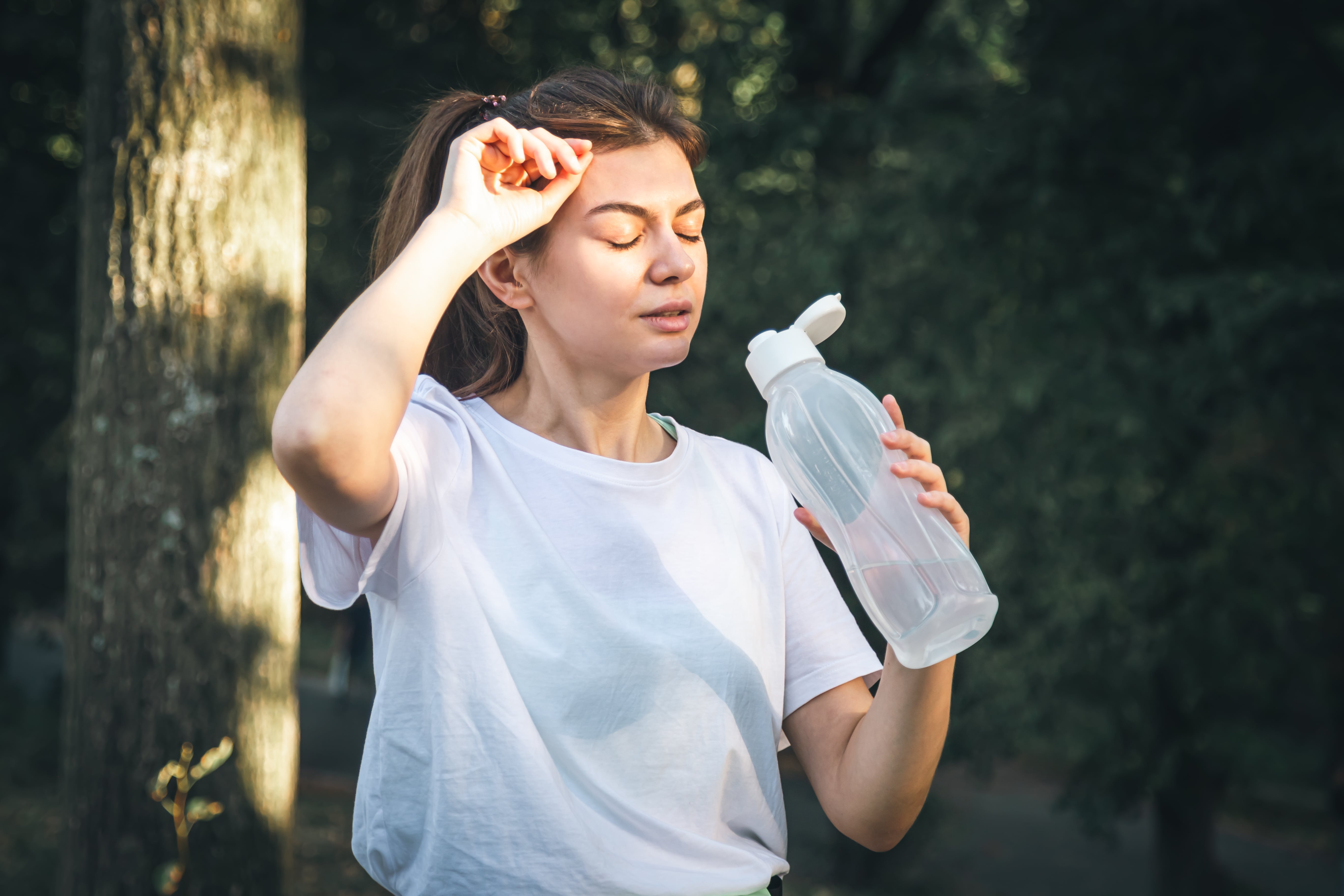Key Takeaways
- Late summer heat, daylight changes, and activity patterns can shift cortisol, ghrelin, and leptin levels, affecting appetite, mood, and metabolism.
- Healthy habits like eating balanced meals, getting high-quality sleep, and managing stress can optimize hormone health.
{{mid-cta}}
As summer winds down and fall rolls in, the shift isn’t just on your calendar; it’s happening inside your body, too. Longer nights, cooler mornings, and subtle changes in daylight all nudge your hormones into a new rhythm.
Most people know shorter days can affect mood (hello, seasonal affective disorder), but fewer realize that key metabolic hormones like cortisol, ghrelin, and leptin also follow seasonal patterns. These changes can influence how hungry you feel, how well you sleep, and even how resilient you are to stress.
Knowing what’s happening and how to work with it means you can make small, strategic shifts to keep your energy, mood, and metabolism steady.
Understanding Cortisol’s Role and Seasonal Variation

Cortisol often gets pegged as the “stress hormone,” but that’s only part of its resume. This hormone also fine-tunes your energy levels, immune function, blood pressure, and the sleep-wake cycle. It’s produced by your adrenal glands and managed by the brain through the hypothalamic-pituitary-adrenal (HPA) axis, your body’s built-in stress-response system.
The seasonal shift: Cortisol levels naturally run lower in the summer and higher in the winter.1 Shorter days and later sunrises can nudge your body to produce more cortisol. One study found a 5% increase in cortisol for every hour later that the sun rose, a measurable reminder of how much daylight shaped your hormonal rhythms.2
Researchers think this rise is tied to tweaks in the cortisol feedback loop within the HPA axis, as well as changes in cortisone receptor activity.1 Translation: your body’s hormonal thermostat is adjusting to the change in light exposure, preparing you for longer nights ahead.
Other late-summer influences:
- Dehydration: even mild dehydration can act as a physical stressor, spiking cortisol.3
- Sleep quality: irregular bedtimes or too much blue light at night can throw off your circadian rhythm.3
- Environmental stressors: lingering heat, travel, and busier social calendars can all elevate cortisol.
How it might feel:
If your cortisol is running high, you might notice feeling wired but tired, more reactive to stress, hungrier than usual, or craving quick energy from sugar or caffeine.
Your late-summer cortisol checklist:
- Hydrate like you mean it: water plus electrolytes on hot or active days.
- Protect your bedtime: aim for consistency and dim lighting in the hour before sleep.
- Build in recovery moments: deep breathing, meditation, or slow evening walks can all signal your nervous system to downshift.
- Seek morning light: a quick dose of early daylight can help recalibrate your circadian rhythm as days shorten.
Keeping cortisol steady in late summer isn’t about eliminating stress; it’s about helping your body respond to it without tipping into overdrive.
Ghrelin: The Hunger Hormone’s Summer Behavior

Ghrelin is your body’s built-in meal reminder. Produced mainly in the stomach, it rises before you eat and drops after, signaling your body it’s time to refuel. But ghrelin isn’t just about hunger; it plays a role in gut health, mood regulation, and motivation by influencing dopamine release.4
The seasonal shift: Studies suggest ghrelin can trend higher in late summer and early fall. From an evolutionary standpoint, this made sense: our ancestors (and most animals) used this time to store energy for winter, when food was less available.5 More ghrelin meant more eating, a survival advantage in a world without stocked pantries.5
In today’s world, however, elevated ghrelin can lead to:
- Bigger portion sizes
- More frequent snacking
- Stronger cravings, especially for calorie-dense comfort foods
Other late-summer influences:
- Increased activity: vacations, outdoor sports, and social gatherings can all raise energy expenditure, nudging ghrelin higher.
- Changes in daylight: shorter days can alter hormonal rhythms, including hunger signals.
- Dehydration: thirst can be misread as hunger, amplifying ghrelin’s effects.
Your late-summer ghrelin checklist:
- Front-load protein: start meals with lean protein to help blunt post-meal hunger.
- Add healthy fats: avocado, nuts, or olive oil help keep you fuller for longer.
- Stay hydrated: aim for steady water intake, not just big gulps when you remember.
- Plan snack safety nets: if you know hunger will hit, prep balanced options (protein and fiber) instead of relying on quick carbs.
By keeping ghrelin in check, you can ride the seasonal appetite wave without feeling like you’re constantly fighting cravings.
Leptin: The Satiety Signal and Seasonal Effects

If ghrelin is the gas pedal for hunger, leptin is the brake. Made mostly by fat cells, leptin tells your brain that you’ve eaten enough and have adequate stored energy. It also helps regulate energy expenditure, subtly guiding how much fuel your body burns day-to-day.
The seasonal shift: In late summer and autumn, leptin levels may dip slightly. Lower leptin levels means your brain doesn’t get as strong a “you’re full” signal, which can make it easier to overeat, especially when paired with higher ghrelin levels.
Researchers think this seasonal drop is an ancient survival tool, encouraging animals and humans to take in more calories before colder months when food was scarce.5
Other late-summer influences:
- Diet quality: processed foods and excess sugar can impair leptin sensitivity, making fullness cues weaker.
- Poor sleep: even one night of inadequate sleep can reduce leptin and increase ghrelin.
- Inflammation: chronic inflammation can disrupt how the brain responds to leptin.
How it might feel:
- You finish meals but still want “just a little more”
- You feel less satisfied by your usual portions
- You’re more tempted by snacks and desserts
Your late-summer leptin checklist:
- Eat fiber-rich foods: vegetables, legumes, and whole grains slow digestion and help fullness cues catch up.
- Get omega-3s: fish, walnuts, and flax can support leptin sensitivity.
- Prioritize sleep: aim for 7 to 9 hours to keep hunger and fullness hormones balanced.
- Avoid high-sugar spikes: stable glucose helps regulate appetite hormones more effectively.
When leptin is working well, your body naturally knows when to stop eating, and that’s a major advantage in staying balanced during seasonal changes.
How These Hormonal Shifts Work Together
On their own, seasonal changes in cortisol, ghrelin, and leptin can subtly influence your appetite, energy, and mood. But when they all shift at the same time (as they do in late summer), the effects can stack.
Here’s the late-summer “hormone equation” many people feel without realizing it:
- Higher ghrelin + lower leptin: You feel hungrier, get weaker fullness cues, and may reach for larger portion sizes or more snacks throughout the day.
- Cortisol on the rise: Sleep patterns can get disrupted, blood sugar regulation may shift, and stress feels harder to shake.
- Less daylight: Mood and motivation dip, which can make healthy routines harder to stick to.
This combo can nudge you toward more eating, less movement, and fluctuating energy, even if your habits haven’t changed much. It’s not “lack of willpower;” it’s your biology responding to the environment.
The good news: when you understand this seasonal pattern, you can work with your body instead of against it. Strategic tweaks to your nutrition, movement, stress management, and daily light exposure can help you stay balanced through the transition into fall.
5 Lifestyle Strategies to Support Hormonal Balance in Late Summer

Seasonal hormone changes aren’t something you can ( or should) completely erase. They’re part of how your body adapts to its environment. But you can take small, targeted steps to keep these shifts from throwing off your metabolism, mood, and appetite.
Think of this as your personal playbook for keeping cortisol steady, taming ghrelin, and supporting leptin sensitivity as summer fades into fall:
Hydrate with intention
Mild dehydration is a stressor that can elevate cortisol and be mistaken for hunger, amplifying ghrelin’s signals. Keep a steady water intake throughout the day, and add electrolytes when you’re sweating more from heat or activity.
Protect your sleep window
Poor or inconsistent sleep can lower leptin and raise ghrelin, the exact opposite of what you want this season. Aim for a consistent bedtime and wake time, dim lights in the evening to support melatonin production, and avoid screens at least 30 minutes before bed.
Build hormone-friendly plates
Every meal is a chance to influence hunger, fullness, and blood sugar. Pair lean protein with healthy fats and fiber-rich carbs like vegetables, legumes, and whole grains. This combination helps keep ghrelin in check, boosts leptin sensitivity, and minimizes cortisol spikes from rapid glucose swings.
Incorporate mindful movement
Regular movement helps regulate cortisol and improves leptin sensitivity, but overly intense workouts can push stress hormones higher. Late summer is a great time for walking, yoga, Pilates, swimming, or other low- to moderate-intensity activities that energize without draining you.
Actively downshift stress
You can’t avoid all stress, but you can train your body to recover faster. Practice deep breathing, short meditations, or take 10-minute nature breaks. Even a slow, mindful walk can lower cortisol and support hormonal balance.
When to Check In with a Professional

Seasonal hormone shifts are normal, but if your symptoms feel extreme, persistent, or disruptive, it’s worth getting a professional opinion. Signs that you might benefit from testing and a tailored plan include:
- Extreme fatigue that doesn’t improve with rest
- Significant mood swings or symptoms of depression
- Severe PMS or menstrual cycle changes
- Unintentional weight gain or loss
- Ongoing sleep disruptions
A qualified healthcare provider, such as a registered dietitian, gynecologist, or endocrinologist, can order bloodwork to check thyroid hormones, sex hormones (like estrogen and progesterone), and key metabolic markers. From there, they can recommend nutrition strategies, supplements, or lifestyle changes that fit your unique needs.
The Bottom Line
Late summer is a hormonal pivot point. Cortisol, ghrelin, and leptin all adjust to changing daylight and environmental cues, influencing how hungry you feel, how well you sleep, and how your body manages stress and energy.
These changes are natural, but they don’t have to derail your health goals. By staying hydrated, protecting your sleep, balancing your meals, moving mindfully, and actively managing stress, you can help your body transition smoothly into fall while keeping your metabolism and mood steady.
Small, intentional shifts now can make a big difference in how you feel when the seasons change. Your body is always adapting, and with the right support, so can you.




.svg)










.svg)
.svg)
.svg)
.svg)
.svg)
.svg)
.svg)
